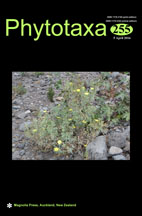Abstract
A new Seimatosporium species was collected from Quercus robur, in Germany. Morphological and phylogenetic analyses (maximum-parsimony and Bayesian analyses) of combined LSU and ITS datasets confirmed that our collection is distinct from other known species. It is introduced here as a new species, Seimatosporium quercina. The new species is compared with other similar Seimatosporium species and a description and illustrations are provided. A taxonomic key is provided to differentiate S. quercina from other morphologically similar species.

